|
Monday, September 1, 2008
Progress Notes
A few weeks ago I wrote about the Thompson family, in particular, Dan Thompson, the carpenter. Another branch of the Thompson family, also located in the Little Saline Valley area, was that of James Earl Thompson (photo 01).
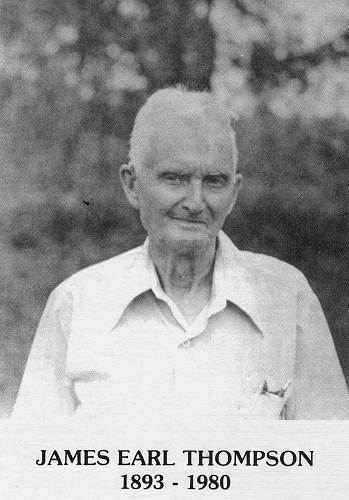
01 Earl Thompson
This week I want to devote some space to James Earl Thompson because of several very interesting aspects of his life. Earl, as he was known around the area locally, was born on a farm just a couple of miles down Dry Creek Road off of Highway 52 north of Tuscumbia. Some of Earl’s relatives still live on the original farm located on Archer Drive. His mother died early in his life and a stepmother was not well liked by the children, a situation exacerbated by the fact that Earl’s father, James Downing Thompson (photo 02), also died while the children were still at home.
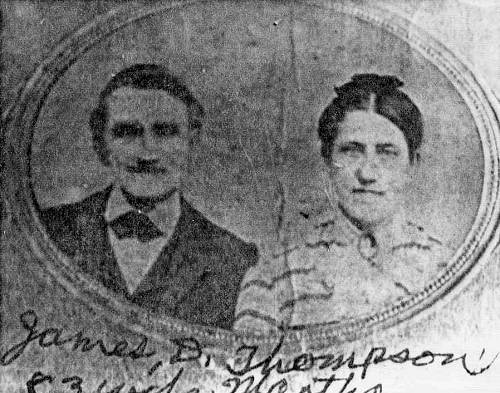
02 James Downing Thompson and Martha, Earl's Stepmother
Because of strained family relations and the extreme poverty experienced, Earl left Miller County and went to Kansas City to find work. His experiences there and later after he returned to Miller County are told in an autobiography he wrote in 1969. Although Earl was raised in poverty, he had artistic and musical talent of an unusual degree. The most amazing part of his story is that while in Kansas City working for the Swift Packing Company, having known how to play the fiddle some, he took lessons from a well known instructor in Kansas and learned to play the violin. Now I know that fiddle/violin is the same instrument which carries two names, generally depending upon what type of music is played. Earl became so accomplished on violin type music that he eventually was selected to hold the second position violinist of the Kansas City Kansas Symphony Orchestra, an amazing accomplishment for a man who had a very tiring day job in a meat processing company.
I found Earl’s autobiography as copied here (kindly loaned me by Clifford Hill of Eldon) very interesting and inspiring, showing that while one may come from very unfortunate and impoverished circumstances, success in life still can be achieved. The style as written is very conversational. In fact, I wondered if it had not been a recording of Earl which later was transcribed since it flows as easily as one would be talking to a friend. However, I am told that was Earl’s style of writing.
Memories That Linger On
James Earl Thompson 1969
My grandfather, Thomas Arrington Thompson, came from Tennessee to Missouri in the year 1860. He settled in Miller County, 3 miles northwest of Tuscumbia. He swapped a team and wagon for several hundred acres of land. My father James Downing Thompson acquired 140 acres of land from grandpa and bought 80 more making him 220 acres.
Dad was married 3 times. His first marriage was to Luticia Cotten in the year 1879. There were 3 children born (the first and third born died young); the second one (Dan) survived to the age of 75. Dad’s wife Luticia, also died in 1887 at the age of 26. In 1889, he married Isaabelle Wyckoff. She was from Moweaqua, Illinois. From this union 4 children were born, two boys and two girls, Ira, I (Earl), Ruby and Gladys. Ira and Ruby have passed on.
(Note: In the next photo (photo 03) the woman is James Downing’s 3rd wife).
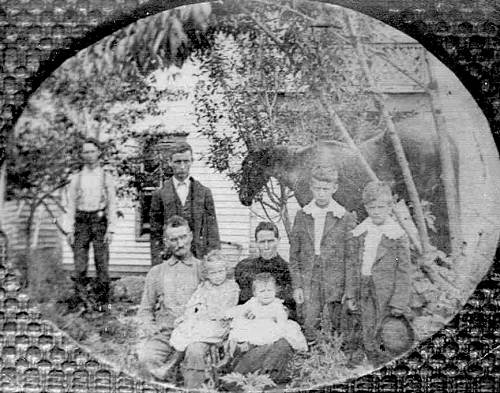
03 James Downing Family
Standing L to R - Andrew Cotten, Dan, Ira and Earl Thompson
Sitting - James Downing and Martha Thompson
In 1890, Dad built a home on his 220 acres; it was two log houses with a breeze way in between. It had a fireplace built on the end of one of them. This was the kitchen and dining room, the other, the parlor and bedroom. I was born here in 1893. Ira and I got our pictures taken in 1895. I am the one in dresses. I wore dresses until I was 4 years old (photo 04).
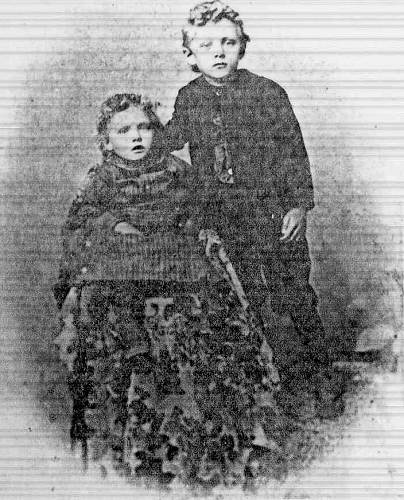
04 Earl and Ira
Dad had one horse and a buckboard. He would go to Tuscumbia in it and Sunday he would take us all to church at the Old Country School house near by. Dad had two brothers that were preachers. Sometimes one of them would preach at the Country School House. We called it “Ginger Ridge.” In those days the house was always full and some standing outside (photo 05).
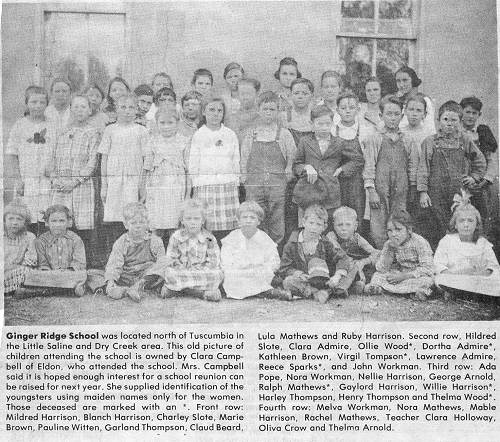
05 Ginger Ridge School
Click image for larger view
In 1898, Dad built a new 2 story, frame house and connected it to the log house that had the fireplace by a hall way between them. Along the side way in the hall there were three wooden barrels, one was for salt (as salt came in barrels in those days), the other two for corn meal and flour (photo 06).
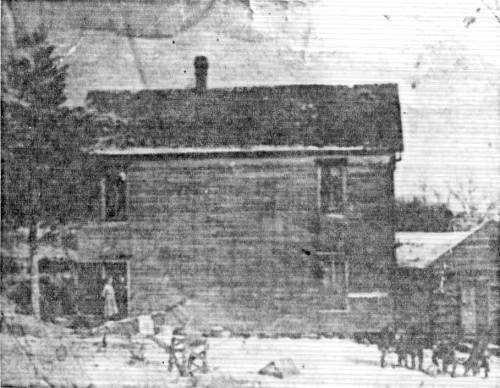
06 Our Old Home from the West
When I was 4 or 6 years old, I can remember Dad taking me with him to Tuscumbia sometimes. Saturday was the day all the farmers went to town to take their produce to market and buy groceries; enough to do them until the next Saturday.
Tuscumbia had about 300 population. There were two Blacksmith Shops, two restaurants, four hotels, a saloon and drugstore, three churches and two grocery stores that kept dry goods and hardware also. There was also a court house as Tuscumbia was the County Seat of Miller County and there was one school house and a Roller Mill. All the porches of the business places in town on Saturday would be full of people chewing tobacco, spinning yarns and whittling. One Saturday I remember when I was there with Dad there was a fellow came in driving an ox team. They were hitched to a two wheeled cart, and the fellow driving was standing up. When dad went in the store to buy his groceries the grocer man’s wife would always give me a sack of stick candy. There were two items I can remember Dad would always buy. A quarter’s worth of sugar and a quarter’s worth of coffee. The coffee was always green coffee beans. Mother would porch it in the old wood stove, then when she wanted to make coffee she would get the old coffee grinder down from where it sat on top of the she safe, put the desired amount of coffee beans in it, sit down and put it on her lap and grind it, then pour the grind in the coffee pot.
Dad kept a few cows and calves; some hogs, a small herd of sheep and a flock of chickens and ducks.
In the spring of the year, when the duck laying season was over, they would pluck the feathers from the ducks. Mother would make pillows and feather beds out of them. Our beds then consisted of a straw bed underneath and a feather bed on top. When we went to bed we would sink down in the bed almost out of sight. They were held up by slats. Sometimes you could hear a slat fall in the nighttime.
In the month of May, Dad would shear the sheep. He would then take the wool to a carding machine about 2 miles down the creek from where we lived. It was powered by a big spring. Sometimes dad would take me along. I can remember seeing the water turning the big wheel (photo 07).
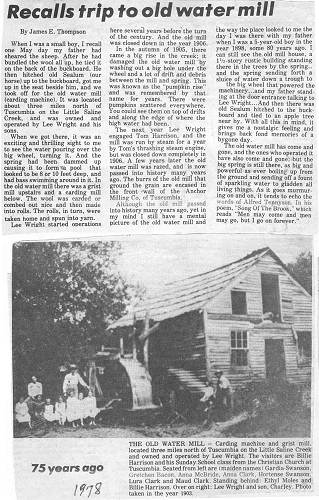
07 Lee Wright Carding Mill
Click image for larger view
The wool was carded and made into rolls about 2 feet long and an inch in diameter. Mother would then spin the rolls into yarn. She would knit mittens and socks for the family. Mother’s sister, my aunt Cynthia, had a loom. We would take her yarn and she wove us blankets. Mother would dye the yarn different colors using walnut hulls, sumac berries and black oak bark for dyes. Aunt Cynthia would make a checker board pattern blankets. She would also weave cloth from the yarn for us. Mother would make dad and us boys shirts with it and also under wear for the family. Anyone that ever wore woolsey under wear will never forget the scratch when you first put it on (photo 08).
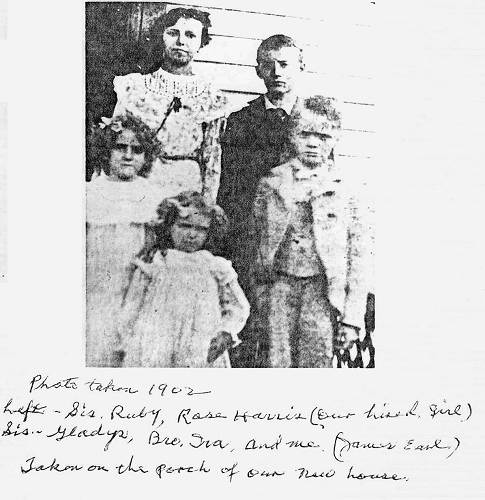
08 Family Photo
Click image for larger view
Most everyone that had land would sew a few acres of wheat for his bread. Dad always did. When the wheat was ready for harvest, he would hire some cradlers…a wheat cradle was a long bladed scythe with fingers above the blade to keep the wheat straight and lay it in a swath. The binders would come along behind and glean up and take a small handful of the long straws, wrap around it, twist the ends together and tuck them under to hold. As soon as the wheat was all tied in bundles, it was put in shocks, and a little while later, was hauled and stacked. It was now ready for the thrashing machine. I can remember the old horse power thrasher. When they came they would have 4 or 5 teams of horses or mules and 8 or 10 men. You had to feed the teams and men while they were thrashing your wheat. Everyone looked forward to the day when the thrashers would come. The neighbor women would come to help with the cooking. They would all cook up a big feast. Mother would put two tables together, as soon as the meal was ready. There would be two women get some leafy branches from a tree, wave them to and fro over the table to keep the flies off. The others would wait on the table, such as taking up bread and pouring buttermilk. Buttermilk was the main drink in those days. Mother would always manage to have plenty of buttermilk on hand when the thrashers came. She had those big glass goblets and some of the men would drink 3 or 4 of them at one setting.
As soon as the corn was gathered in autumn, Dad would always plan on getting in a good supply of corn meal and flour before winter set in. He had a large pine box in the corn crib with a corn sheller fastened onto the side of it. We kids would shuck the corn, then one would turn the sheller and the others would feed it. When we got the desired amount shelled, Dad would sack it up and also a sack or two of wheat and take it to the Tuscumbia roller mills and have it ground. He would try to have the old wooden barrels in the hall filled up well before snow fell. Most everyone called meal and flour bread stuff. It was generally assumed when the snow came if you had plenty of bread stuff on hand you were well heeled.
About 1900 mother became sickly and we kept a hired girl to help her most of the time. We had several different ones. Dad paid them 50 cents a week. I remember one of them, Etta Dougety was constantly singing. I thought she sang so beautifully. I was 7 or 8 years old then. The family lived on our place in a log house. After I got grown up I tried to locate them, but no one seemed to know where they had gone. She had two sisters, Jennie and Lula and two brothers, John and Fred. Her father’s name was Bill. She would be in her 80’s now, if still living.
In 1903, mother died at the age of 46. The neighbors dug the grave and dad bought the lumber to make a box and coffin. A carpenter built them for nothing. The total funeral expense was $2.50, the amount dad gave for the lumber. This changed things somewhat. Our hired girl left and Dad did the cooking, which was not so good, but it was not long until one of his cousins came to stay with us, Elizabeth Greenup. She was an elderly lady and a good cook. She was glad to stay just to have a home. She liked us kids and we thought a lot of her too.
My job in the evening then was to get the cows. I knew all the old cow paths through the woods. There was no stock law, so sometimes the cows would range out quite away from home. They had on two bells and I could hear them along ways away. In Autumn I would always go by the persimmon and black haw patch and eat my fill. Dad had a bull he had raised from a calf. We kids made a pet out of him. We broke him to ride. He was gentle as a dog. When I found the cows I would start them toward home and them and I would hop on the bull and ride in. He would just follow along behind. I had no halter or rope on him.
At supper time we would always have about the same thing. The cook would bake a pan of corn bread on the fireplace heath in an old Dutch oven. She would make it with plenty of buttermilk and eggs, then draw the mild and butter up out of the well and we would have corn bread and milk and hot corn bread and butter. There never has been a meal like it since.
In 1907, Dad got married again. He married an old maid from Tennessee. A cousin of his had got them to corresponding with each other and he decided to go to Tennessee and marry her and bring her back with him, but after he saw her and talked with her he came back alone. She kept on writing to him until at last he went back and married her and brought her home with him. She was a typical old maid, cranky as they came. She had hoed cotton all of her life and knew very little about cooking. She never gave us kids a kind word. Her cooking was terrible. The corn bread was hard as a rock. You could play ball with one of the biscuits. She would scorch the gravy and burn the meat and when she made pies the crust was half dough. My job in the evening was still going after the cows. After eating Martha’s cooking the persimmon and black haws tasted better than ever. My brother Ira and half brother Dan could not get along with her at all. They were all the time quarreling and finally got to fighting. Dad would always separate them. After breakfast when we all went to the field to work she would give the little girls a spanking just for the fun of it or maybe she would be mad at Ira or Dan and take her spite out on the poor little girls. They were scared to death of her. They would not tell anybody about her whipping them because they thought she might beat them to death. My oldest brother, Ira, suspicioned something was wrong by the way the girls acted. The next morning when we all went to work, Ira came up behind her, knocked her down with his fist and gave her a good beating. She never touched the girls anymore. There was one thing about Martha, she always had a good garden. She was out at daylight hoeing it. Everyone that came would brag on her garden. She hated Ira and Dan like rattlesnakes, but somehow or other she seemed to like me. She never tried to boss me. We put up with this raving inferno of humanity for 7 years. In February 1914 dad died. She now began to sell all he had. She did not know the value of anything. When someone made an offer she took it. She sold all the cows and calves, the hogs, sheep and all the chickens and ducks also some of the house furniture. She was going to sell her part of the farm for $25.00.
There was a singing school teacher that lived nearby that thought a lot of us kids (as we went to his singing school a lot and learned to sing the Do Re Mi system). He came over and told us that she was going to sell it and by all means for one of us to buy it, that whoever bought it would have controlling interest in the farm as long as she lived. But we did not have the money. Dan, my half brother, had 3 cows and he sold them for $50.00 which was a fair price then. He offered her $50.00 for her interest in the farm and she said no. So it looked like the only solution was for me to buy it. Dan said he would loan me the money. That was the 4th of April, so I asked her if she would sell it to me and she said yes, but we had to wait until April 8 before I was 21 years old. Our nerves were on edge. We were afraid some one else would come and offer more, but as good luck would have it the morning of the 8th we went to Tuscumbia, had a lawyer fix up the deed and she signed it. We now felt more at ease. She came home and packed her trunk and some pine boxes full of bed clothes, dishes and other things, she never brought with her when she came. She hired a neighbor to take her to the railroad station at Eldon. When she left she told me good bye, but said nothing to the others. She had left us in a predicament that we never had dreamed of could happen to anyone. There were no cows to give milk or butcher a beef, no hogs to kill, no sheep that we might kill mutton, no eggs to gather or chickens and ducks to kill and eat, no nothing. However, she did leave some bread stuff in the old wooden barrels in the hall and some salt pork in the smoke house.
Dad was a Civil War veteran and got a pension and with that we were raised on the farm. We never knew what it was to go hungry. We never had any money, but had always had plenty to eat, but it was different now. It was the wrong time of the year to kill rabbits and squirrels; however, I did take the girls out a few times and gather some wild onions and greens along the creek, which went good with the salt pork. It looked like the only solution was for us to get a job. There was no work in the immediate vicinity except possibly a job as farm hand with some of the well to do farmers. If they hired you it was not by the hour or day. The pay was $10.00 a month and you worked from cock crowing in the morning to whippoorwill at night. One of the boys I chummed with wanted me to go to Kansas City with him. This sounded good, but I did not have the money to go on, so I decided to make a load of rail road ties. I had never made a tie in my life. I did not even have a broad ax to hew them with, but I knew the dimensions they had to be, so I sharpened up the two bit chopping ax and Ira helped me saw the timber and I started in on them. It took me about a week to make 10 ties. I got them the right size okay, but they were not hewed smooth like they should be. They looked rough and hairy. I hired a fellow to haul them to Tuscumbia and the merchant bought them, after he paid me for them he pulled a hairy splinter or two off and said, next load you bring in singe them before you start.
We got our suit cases packed and carried them 10 miles to Eldon. I hated awfully bad to have to leave the old farm where I lived for 21 years. It was like deserting your best friend the nostalgia sank into my heart deep, but I knew I could not stay there. I had never been in a large city in my life or worked on public works. When we got to Kansas City, Grover’s brother met us at the Union Station. We took a street car over to his house in Kansas City, Kansas. The first one I had ever ridden on. Grover’s brother already had both of us a job for Monday morning. Grover went to work at Swift’s Packing Company and I had a job at a wagon factory. When I got hired and work time started at 7:00 o’clock everyone started in a run. Most of the jobs there were piece work. There was a bunch of fellows nailing floors in the wagon beds. The hammering sound to me was like a hail storm on a tin roof. There were fellows pushing hand trucks loaded with wagon parts to and fro in the isles going in a run. I came very near getting run over two or three times, finally, the boss gave me a job in a room to my self. I was riveting hooks on the wagon seats that hook over the bed.
It was now early June, the weather was getting hot. There was a well outside where everyone got a drink. The water was yellow colored with iron rust. I could hardly drink it. It tasted awful. Some of the piece workers would come out to get a drink wiping sweat, would pump up about a quart of the yellow stuff and drink it down, iron rust and all. “No iron poor blood there.” I made 15 cents an hour, worked 10 hours a day 6 days a week. After I had been there two weeks I decided surely there must be a better way, so I quit. Next Monday I got a job at Swift’s where Grover had got a job. I liked it much better. I got 171/2 cents an hour there. Made $10.50 a week. The boss got $15.00 a week straight time. My board and room and laundry cost me $4.50 a week and I had $6.00 left. When I got a few pay days I sent the kids down home some money and they bid the old home good bye and came to Kansas City and got jobs. My job here was weighing barrels first empty and then full of oleo oil. The boss seemed to like me fine and when he found out I was from the country he liked me even more. He had been longing to have a piece of ground in the Ozarks and go into the chicken business and the old fire chief there at Swift had the same idea. He would come over and he and Mart (my boss) would for an hour or two talk about it. Sometimes they would ask me over to find out all they could about the chicken business. They could not figure out why anyone on a farm like I was would come up to Kansas City and to work in a place like this.
I worked here from June to early October and decided I just had to go back down to the old house and look it over and see all the boys and girls once more. When I got there they were all glad to seem me. They would have parties, and candy breakings somewhere almost every night. I stayed all night with the neighbors most of the time and when I stayed at home some of the boys would stay with me. The county then was full of boys and girls about my age. I went over and visited the old persimmon and black haw patch and ate my fill once more. I bought a dozen hens that was laying eggs from a farmer, gave him 25 cents each for them, so I could have fresh eggs to eat while I was there.
In a little while I took the typhoid fever. I knew Dad’s old remedy; take enemas and eat light. The neighbors found out I was sick so they sent the kids in Kansas City a telegram and came to set up with me. One night my cousin was with me, we heard a roar, thought the flu was burning out, got outside, but could see nothing. Pretty soon up came a Model T Ford. It was the kids from Kansas City. They had hired a taxi from Eldon down, jumped out and ran in the house. I now felt a lot better. The next day we had the doctor from Tuscumbia come to see me. After he asked a few questions and took my temperature and pulse, said I was getting over the Typhoid fever and doing fine. In a few days I was up and felt fine. We all decided to go back to Kansas City, so I sold the chickens, all but one big Plymouth Rock we intended to eat for our last meal, have a lot of chicken and dumplings. The night before we intended to start back to Kansas City we had a party. The girls gathered bouquets of wild flowers, put them in vases to decorate the room. Most everyone came brought fiddles, guitars and cello. We had a music party and played games. One of the main games then was snap. It was a kissing game as all the old timers know. Everyone had a wonderful time. When the party was over everyone shook hands with us and bid us good bye. The next day we dressed the old Plymouth Rock Hen, had a pot of chicken and dumplings. I was afraid I would eat too much just getting over the Typhoid. I had a raving appetite. When we finished dinner the girls washed up the dishes and put them in the cupboard and hung the pots and pans on the kitchen wall. We closed up the old home once again and all went back to Kansas City.
I got my old job back at Swift’s, worked there for several years, wages kept going up. When war was declared on Germany I registered. Boys began to go to the service, it seemed like they never would draw my number. My brother Ira had gone and about all of my pals had gone. Finally, on July 15, 1918 I got my orders. There were 500 of us left Kansas City and went to Camp Funston, Kansas. They ran us through the mill. Gave us uniforms and a rifle. I marched over the hills of Funston with a pack on my back and rifle for two weeks; it was really rough in the July sun. After two weeks I got transferred into the Medical Corps. This was a lot better. We would go out on a hike, sit down in the shade and the Medical Officer would lecture to us about germs, how to tie bandages, splint broken bones, etc. The next Sunday I found my brother Ira. We had our pictures taken together. This was taken in August, 1918. I am the one on the right (photo 09).
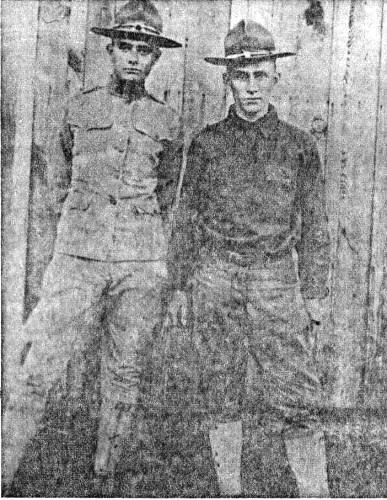
09 Ira and Earl at Camp Houston
It was not long until the flu epidemic hit the camp and it really hit soldiers. They were dying like flies. The base hospital at Fort Riley, Kansas (near Funston) could not begin to hold the sick. They set up emergency hospitals using barracks at Funston. Doctors and nurses were as scarce as hens’ teeth. Things got so bad they put me in charge of an emergency hospital nights. They were all colored boys except me and the cook. There was about a dozen bed patients and 75 or 80 suspects. My job was to take temperatures and pulses of the bed patients and if any seemed to get worse call in about it. The most of the boys seemed as well as I was. They would get out in the latrine at night and shoot craps until late. There would be a doctor or nurse come by about once in 12 hours. One of them told me there were 800 died in one day and 4 or 5 hundred a day was common. But in a few more weeks it began to die down and they done away with the emergency hospitals and November 11 the Armistice was signed. Soldiers began to jump up and down and run to and fro everywhere. Everyone wanted a paper for the news All you could hear was someone saying, “have you got a paper, have you seen a paper, where can I get a paper…” One of the boys in my outfit picked up an old paper in the barracks about a week old folded it up nice and put it under his arm, jumped outside and hollered “paper!” There was about a 100 came running at him. The first one there grabbed the paper, gave him a dime and ran. He also ran back in the barracks with the dime. In a few weeks they started discharging the troops. I thought I would soon get to go home, but instead they put me on the demobilization board as a clerk. I worked all winter. We had everybody discharged far and near except a skeleton force to take care of the camp they had reenlisted. It was now March, I thought sure I would get discharged now, but instead they sent me and 5 more clerks along with 75 re-enlisted men to Fort D.A. Russell, Wyoming.
It was the 23rd of March when we left. Spring had practically come, but when we got to Cheyenne, it was winter; we had to go through another short winter. It was four miles from Cheyenne to the Fort and they marched us to it. The wind was blowing at gale force right out of the Northwest. The soldiers ahead with their hob nails on would stir up the gravel and the wind would blow it and hit us in the face behind. I was a buck private in the rear rank. I had jobs that I could have got a higher rank if the war had not ended, but now they would not give me a higher rank unless I would reenlist, but I did not do that. I got $30.00 a month with $7.25 taken out for insurance and laundry. Gave me a cash payment of $22.75 a month when we got to the Fort; it was a beautiful one. The buildings were all made of brick with double windows.
I was here on the demobilization board for a while and they made me a dental assistant. I helped 2 dentists, Lt. Blue Rock from Oregon and Captain Stewart from Kansas City. My job was to sterilize the tools and make appointments. When the dentists would leave on Saturday they told me to clean teeth and make a little money if I found anyone that wanted his teeth cleaned. I had a few customers. I charged them $.50.
I thought winter would never get over with. It came a 2 inch snow the first day of June, but July and August the weather was superb. The Red Cross would take a truck load of us occasionally out on a picnic, sometimes we would go boat riding on Lake MineHaHa near Cheyenne. During the summer they had a rodeo near Cheyenne. They had bull dogging, bare back riding and there was two movie stars there. They were Fred Stone and Prairie Rose. They did a lot of trick riding. One of the soldiers in our outfit took first prize for staying on the longest bare back riding. His name was Armstrong. Fred Stone came out to the fort and entertained us one night. The Red Cross passed the cigars around and when everyone fired up, you could hardly see Fred for the smoke (photo 10).
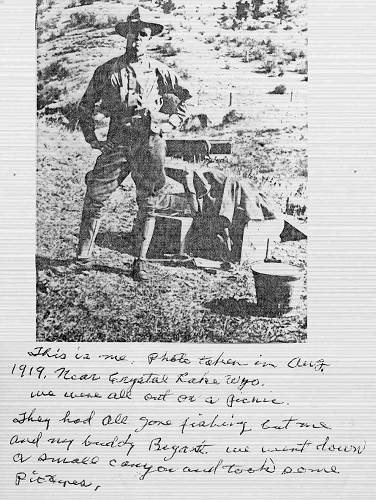
10 Wyoming
Click image for larger view
When the month of September came, we knew it would not be long until winter set in. The altitude here was 6500 feet and winter started early. The 20th of September it came a 2 inch snow, we knew winter was just around the corner. The war was over and we wanted to get discharged bad. Finally, the good news came on the 30th of September 1919 and we got our discharges and all headed for the open spaces. Five of us started to Kansas City. We had a stop over at Denver. We went into a café and had a steak meal with all the trimmings then hopped on the train and went to Kansas City.
When we got there I bid my buddies good bye and I visited relatives and friends for a while. Went over to my sister Gladys’ where I had left my civilian clothes. Put on my old civies. I now felt like myself again. Before I looked for work I went down to the old home again to see how it was. When I went in the first thing I saw was the bouquets the girls gathered the night we had the party. They were 5 years old and all wilted and dried up. The first night I was there I stayed all night with my cousin. Things were much different here this time than they were the last time I was here. Most all the boys and girls near my age were gone. Some had got married others gone to the armed forces and some had gone to the cities to work during the war boom. There was no one to visit with. After spending the night with my cousin, I came back to the old home place that afternoon. I wandered over the hills and vales all afternoon looking at the beautiful autumn colors. When I got back to the old home it was almost sundown. I was lonely and blue. There was no one to talk to as I had before when some of the boys would stay all night with me. There were no parties to go to. The night was lonely and still. The whippoorwills had flown south. The hoary frosts of October had silenced the katydids and crickets. It reminded me of an old song our hired girl Etta Dougety once sang…”Gone are the loved ones I cherished of yore, there is no one to welcome me home.” I lit the coal lamp and went upstairs to go to bed. There was the old bed just like I crawled out of it five years ago. I took the old quilts out on the porch and shook them good, stirred up the feathers a little, spread the sheet and quilts on the mattress, turned the lamp low and hopped into bed. It was indeed the still of the night. I thought about what Uncle Josh once said on a phonograph record, “Things was so quiet you could hear your hair grow.”
I was rather weary from walking over the old hills of home all afternoon so it was not long until I was sound asleep. I got up rather late next morning, got my suitcase and went to Tuscumbia, ate a good meal at a restaurant, hopped the mail truck to Eldon, boarded the train for Kansas City…got a job at Armour and company. I was weighing meats in the wholesale market. Worked there a year. I was now 27 years old. My brother and both sisters had got married. About all of the old chums I had run around with were also married. I was reminded of the old song “Wedding Bells are breaking up that old gang of mine.” So I decided it was about time for me to find the right one. One night I was watching a movie, it was rather late and most of the seats were vacant. Two girls came in and sat down in back of me a few rows. I looked around and they smiled. I went back and got acquainted with them, took both of them home that night as they roomed together. Their names were Mamie and Edith. Mamie said she came from Osage County, Missouri, a county that joins Miller, the county I came from. Said she was raised in the country and liked the country better than the city. Her family had come to Kansas City during the war boom and she had been working in a factory. It looked like we had a lot in common. I kept coming to see her. The more I was with her the better I liked her and she seemed to think a lot of me too. Sometimes on my way to see her I would stop at the grocer and get a frying chicken. She would fry it and fix us up a real meal. She was an excellent cook and a good and kind hearted girl and good looking too. So I popped the question. She said yes and in a short time I bought the ring and on the 26th day of March A.D. 1921, I took the fatal step. We decided to stay in Kansas City for a while and save up enough to start out on when we did go to the farm (photo 11).
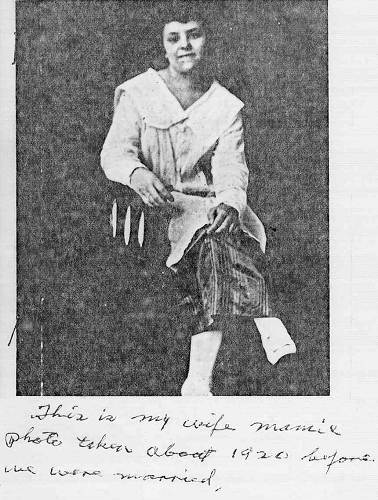
11 Mamie
Click image for larger view
In the meantime my half brother Dan and I had bought out the other heirs in the farm and we divided it. I got 140 acres and he 80 with the house on it.
Mamie’s father, John Roberts (photo 12), wanted to go down on our 140 acres and build us a log cabin.
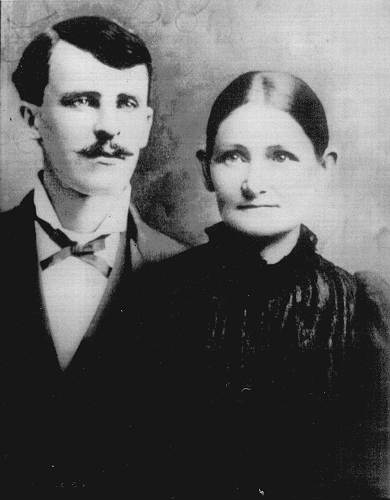
12 John and Olatha Roberts - Parents of Mamie Thompson
We told him okay. I had a Model T Ford car. One evening we packed it up to the brim, put his tent and tools in, his bedding and a small stove and got it all packed to go. The next morning early, Mamie wanted to go awfully bad, she had never seen the place, but there was no room as the front seat just held two. The next morning we got up early, cranked up the old “Jumping Jenny” and headed for the land of a million smiles, we were 14 hours making the trip 150 miles. After we left the outskirts of Kansas City it was all mud road except a few miles of pavement in Sedalia. You had to stay in the ruts or you might slip off in a ditch. If you met a car you had to stop and get out and fill in the ruts ahead of you so you could pull out and carefully pass each other. But believe it or not, after we left the pavement at Kansas City, we came the entire distance, 150 miles and never met a single car (except two in Sedalia on the pavement). That was, of course, in 1921. It was after night when we got there. We stayed all night with my cousin. The next morning early we unloaded everything, put up his tent and bed, set up his stove. I showed him where to build the cabin and I hopped in the car and hurried back to Mamie.
This time I got a job as a street car conductor. Took a notion to take violin lessons. I took lessons about 6 months then quit the violin and took lessons on the guitar for a while and quit it. Next I took a correspondent course on the violin from the Siegel Meyers School of Music in Chicago. Completed it in about a year. Sometime after that I ran onto a music teacher by the name of Fredric Cooke. He had a 48 piece orchestra. I took violin lessons from him for a while and he put me in his orchestra playing second fiddle. We would practice in the Jay Hawk Hall on Minnesota Avenue in Kansas City, Kansas. Played around at several towns and played once over WDAF Radio Broadcasting Station of the Kansas City Star. That was when the head phones were in use. The name of his orchestra was “The Kansas City, Kansas Philharmonic.”
(Note: Earl wrote an article for the Autogram in 1977 describing this trip to Tuscumbia. It is copied here since it fits in with his story.)
Autogram: 1977
(James Earl Thompson, Tuscumbia, “almost 85,” who learned about streetcars before he did about automobiles, describes a trip from Kansas City to Tuscumbia more than 55 years ago in his first car. He recalls he traveled through Sedalia, then down to Cole Camp and to Eldon. From Eldon he motored through what was known as “Vernon Hollow” and on to Tuscumbia. “If you pulled that hill (Vernon hill) in high, you’d done something,” he said.)
By James Earl Thompson
In the year 1922, I was a streetcar conductor in Kansas City. Had a vacation coming up July 1 (about a month). I owned a farm in the foothills of the Ozarks near Tuscumbia, about 150 miles. My wife and I had planned to spend my vacation on this place, as her father and mother were living on it.
About two weeks before vacation time I bought a Model T Ford; it was a 1918 model touring car.
I bought a set of new tires and put on it, and we got it all shined up for the trip. My sister, Gladys, and her two small boys were going with us. When vacation time had come, we got it all packed the evening before. Next morning I cranked her up and we took off in that automobile with all our pride and dignity.
When we had gone about 40 miles, the motor developed a knock; it was getting worse; I stopped and got out to see if I could find the trouble. I knew very little about a car. I raised up one side of the hood, stared at it, scratched my head and wondered. Just about then two fellows came up in a truck.
The driver got out and said to me: “Having trouble buddy?”
I replied “Yes it was making a hammering noise.”
“Will she run?” he asked.
I told him I thought she would run all right.
“Crank ‘er up and let’s see how she sounds,” he said.
I gave the crank a spin, and the motor started hammering away. He said something but I could not understand for the noise. I shut it off and he replied: ”Yer connectin’ rods are burnt out. There’s a good Auto Mechanic in the next town one mile on down the road. His name is Jim Necessary.”
I told him the name sounded good, as it would certainly be necessary to have it fixed.
He then started to go around me and got one side of his truck off the pavement on the wet grass and got stuck (It was easy to get stuck in those days, as trucks had solid tires behind). His partner got out and he and I pushed and we got him back on the pavement.
I then cranked up the old hammer mill, and we started for Lone Jack to find Jim Necessary (the auto mechanic). It sounded like someone inside with a jack hammer. On our way as we would pass houses, people would come to the door and look out to see what it was going down the road. It seemed like a very long mile, but when we finally got to Lone Jack, Jim Necessary had heard us coming, and waved us right on into his garage, which was more or less just a shed by the roadside.
“Sounds like you’ve really burnt ‘em out, “ Jim said.
He then checked the oil and said: “Yer oil’s all right, must be something else.”
He then took the oil pan off underneath and said “yer oil line is stopped up.” He went on to say I needed three connecting rods and an oil line. He told me he would have to pull the motor to do a good job of it. I asked him what all this would cost. He said if I would help him do the work and pay for the parts used, he would only charge me $12. I told him that would be just fine as I wanted to learn something about the contraption anyway. When we got it all torn down, Jim loaded the three connecting rods in his Ford Roadster, and took off for Lee’s Summit (a town about 12 miles away) to get new parts.
While Jim was gone, my wife and sister, Gladys, and her two boys (William and Harley) came down from the general store to the garage. They had food they bought at the store, and we all ate dinner. It was not long ‘til Jim came back with the necessary parts to fix the car. As soon as Mr. Necessary had eaten his dinner, we started putting it back together. Jim had some bearing blue. He would put some of it under a bearing and tighten it down He would then take it off and the bearing blue would tell him where the high spots were. He repeated this several times until the bearing fit perfectly. Jim had the necessary technique it took to do the job right.
When we got it all together, the sun was getting low. Mamie came down again from the big store, and said the people who ran the store wanted us to stay overnight with them. Said they would set up beds in the store building for us, and the lodging would not cost us anything. I told her that sounded good. I asked her what their name was. She said their name was Devine. I told her it sounded like everyone here in this town had the right name.
When Jim and I got the car all put back together, Jim jumped in behind the wheel, and asked me to “crank’er up.” It started purring like a kitten. I could tell it sounded better than it did when I bought it. Jim says “Hop in and let’s drive her around a few blocks.” I got in and when we returned, Jim says, “she sounds like a sewing machine.”
I had a fiddle and guitar with me. Jim saw them and said, “Let’s have some music tonight in the general store.”
I told him that would be fine. Along about dark, Jim came in with several others. We got out the instruments and started tuning up. People kept coming in. When Jim had played a few tunes, the store was full of people. I suppose there would have been a dance, but there was no room. The Devines sold out on a lot of items they had in the store that night. Most everyone was patting their feet and clapping their hands. When Jim would get through a tune, someone would call out another, and Jim would take right off on it. Jim furnished the necessary music the crowd wanted. I accompanied him on the guitar. When we got through, my fingers were worn to the quick. Jim played everything from “Sallie Good’en” to “Pop Goes the Weasel.”
When the music was over, the crowd soon dispersed. The Devines had two nice clean beds set up for us, and we were certainly tired. When we crawled into them, it was really something devine. We all slept like logs. Got up early next morning. The Devines were up, too. We bought some food from them to take along with us, and once again we were on our wayward way, thinking of the necessary service we had received from Jim Necessary, and the divine hospitality given us by the Devines.
When we had gone about four miles, the pavement ended. We hit the dirt road. It had been raining in places, and sometimes we would come to a strip of muddy road. Mud holes were common in those days. My brother-in-law (Dewey Hatfield) had taught me how to drive through a mud hole: “Stay in the ruts and give’er all she’s got.” I found this to be a good policy. When I came to a mud hole, I would go bouncing through it slinging water and mud in all directions, and my sister’s head hitting the top in the back seat, but we never did get stuck.
On our way we came to a muddy stretch of road for a mile or so. We had to stay in the ruts, which were in the middle of the road. If you got out, you might slip into the side ditch. If you happened to meet another car, you had to stop, get out and shovel in the ruts ahead of you (a shovel was standard equipment in those days for a car). You then pulled out, passed each other carefully, turned back into the ruts and you were going again “Finnegan.”
We would have to stop at about every filling station and fill up with gas and put in a quart or two of oil. On our way we saw a car parked ahead, and it looked like a family sitting under a shade tree.
When I got near the man came out toward us and waved me down. I asked, “What’s the matter, buddy?” He replied, “Well sir, I was motoring along as purty as you please, and all at once it sounded like someone got mad at the motor, and threw a monkey wrench at it and she quit me.”
He then asked me if he could ride to the next town (which was six miles). I told him I had a load but if he could hang on somewhere I would try to take him. He replied, “I’ll do that; I’ll just stand on the running board.” (He was a big man, would weigh 250 or more). When he stepped on the running board, it felt like the car listed 30 degrees or more. We shifted ourselves and some of the cargo to the other side as much as possible and it helped some, but it was still like riding on a hillside.
When we had gone a few miles, the car was making a noise. I got out to see what was wrong, and saw the hind tire was flat on the side the man was riding on. I jacked up the wheel, took off the tire, patched the tube, and began to pump up the tire. The man who was riding with me took turns with me pumping. When we almost had it pumped up, the car fell off the jack and the tire on the other side went flat; I got it fixed and back on, and all we had to do was pump. The sun was at its zenith coming down with all its July strength. When we got through pumping, the sweat was running off us like an April rain. We were both completely exhausted. I cranked her up again, and when we got up a little speed, the breeze really felt heavenly. My wife took her handkerchief and wiped the sweat from my brow, and said: “Are you tired, honey?”
When we got to the next town, the big man got off, and the old boat straightened up to an even keel. He found an auto mechanic, and we filled up with gas, and put in a quart of oil, and once again we were on our way to our Ozark retreat.
When we were about 40 miles from our destination, we came to a strip of good road. It was smooth and downhill. There was a creek to cross at the bottom. I had never crossed a creek in a car in my life. The thought came to me that a creek should be crossed something like going through a mud hole…”give her all she’s got!” I pulled the gears down on the old jalopy. Going downhill on smooth road, we must have been making 40 miles per hour. When we hit the creek, there had been a hole washed out about four feet deep. We just parted the waters and went on through. We came out safe on the other side; no one got a bit wet, but the motor drowned out. I got out and looked at the hole of water. I estimated if we had stopped in it, the water would have been up to our necks. I then took the foot pump, and blew the water out from around the spark plugs. The motor was hot and in a few minutes she was ready to go again. I cranked up the amphibian and once again we were on our Ozark journey.
When we had gone about 10 miles, we came to a filling station, filled up with gas again, put in two quarts of oil, and I bought two extra quarts of oil to take along with us as we still had about 30 miles to go. When I cranked her up to go, the emergency brake must have been wet, it slipped off and the car took off. It was somewhat downhill. I jumped out of the way, and took in after it; had to run to catch it. I jumped on the running board; slid myself in behind the steering wheel, and once again we were on our way to our Ozark Utopia.
We made it fine the rest of the way. When we got there, we were all completely worn out. Mamie’s mother knew we were coming and soon had a good meal prepared. We all ate our fill, made us a pallet out in the yard under a wide spreading oak; stretched ourselves out in the coolness of its shade where we could inhale the essence of the summer breezes and hear the birds sing.
In 1927 Mamie’s father and mother wanted to come back to Kansas City. It was late March. Mamie and I decided to go down and take over. We had stocked them up with a flock of chickens and some cows. They got a cousin of mine to look after things until we got there. They came back by rail. We were anxious to get started and see the beautiful springtime and hear the birds sing. When we got started it was up in April. We knew it was the time of year when the springtime in the Ozarks would be at its best. We could hardly wait to get there. It looked like at last our dream was about to come true. We loaded the old jalopy full as we could get it and shipped some things we wanted to keep. We now had 3 kids. The next morning early we put the two oldest kids in the back on top of the mattress and quilts where they could go to sleep if they wanted to. There was no danger of falling out. We had the sides all closed up with everything and things tied on the outside. Mamie wrapped the baby boy in a blanket propped up in the front seat and I cranked up the old puddle jumper and with shovels, rakes and hoes tied on the outside we took off for the garden spot of America. This time we were 15 hours going the 150 miles but we stopped and ate a few times. When we got in about 40 miles of home, the sun went down. Night came, we turned on the magneto lights and kept plodding along. When we got there it was up in the night. I went in, lit the coal oil lamp started a fire in the wood stove, brought Mamie and the boy in and the two girls. We warmed some soup up we had along with us. Ate some hot soup and crackers. When we got warmed up good we got sleepy, so we all went to bed and drifted into the land of dreams.
The next morning our neighbor’s daughter came up. We had just got up, we were anxious to get out and look at all the beauties of nature, we left the girl with the babies and we stepped out. The sun was shining bright, the bees humming, chickens cackling, birds singing. It looked like the spring had greeted us with open arms. The red buds and wild plums made a continuous bouquet along the creek as far as you could see. The hillsides were adorned with splashes of white by the dogwoods. The old back of our house was covered with bald pinks, verbenas and yellow primroses. Flowers were blooming everywhere. The roadsides and meadows were strewn with sweet Williams, dandelions, daisies, violets, cow slips and many, many more flowers that we did not know the names of.
(Note: I thought some readers might want to see some photos of these flowers which were growing wild on Earl’s farm. So here is a collage of some of them (photos 14a and 14b).)

14a Wild Flowers

14b Wild Flowers
The blue jays had taken over the largest tree in the yard. There was a pair of robins on a post oak on the east side. There had been some boxes put up for the blue birds, but the red headed wood pecker had taken them over. The house wren was hopping up and down on the end of the logs of the cabin, singing its familiar song, “to what, to what, to weeee…” I could hear the song of the brown thrush echoing from the wood lands; sounded like he hit the first three notes of Tchaikovsky Piano Concerto #1. The meadow larks standing on the fence posts as we passed by would seem to sing a few notes of Mendelssohn’s Spring Song.
(And here is collage of some of the birds described: (photo 15))
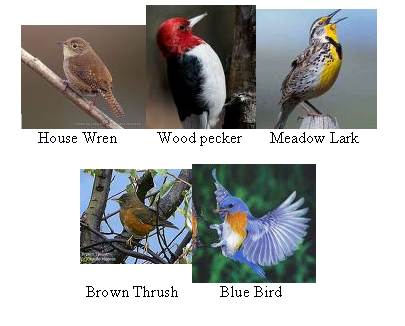
15 Wild Birds
We went over to the creek. It was running clear, cascading over the clean rocks, murmuring a song that seemed to blend in with the other voices of spring. We spent the entire day wandering over the hills and vales. The spring where we got water to drink was running a sluice of clear cold water sending off a dale to quench the thirst of all living things. We got the old gourd hanging by it and took a drink. I thought to myself: how much better this is than the water we had at the wagon factory!
We could smell the aroma of plum blossoms as the breeze went drifting by. I have seen a lot of springtime in my life, but this one seemed more beautiful than any yet.
We had planned so much to do, we did not know what to do first. So we decided to cleanup the yard. I trimmed up the trees and grubbed up the buck brush and Mamie piled it off and we burnt it. We then white washed the tree trunks and raked off the yard. There was about an acre of it. It now looked liked a little park. The birds seemed to like it better too. Sometimes a mocking bird or a cat bird or oriole would come and perch in one of the trees and sing. Next we decided we needed more room. I had some lumber hauled and built on another room. This was our dining room and kitchen. It had a dirt floor. Next I got the garden all plowed up and ready and we started planting, everything we thought we could use. We also set out a row of grape vines and planted some peach trees. Everything went fine until summer came. Then we began to find out everything was not roses. The ground hogs started eating up the garden and the hawks were catching the chickens. I got a shot gun and kept a close watch. After I had killed 7 ground hogs, the eating in the garden stopped. They had eaten 32 heads of cabbage and all the leaves off the beans. I killed one hawk and that stopped them from catching the little chickens.
In 1929-1930 the Bagnell Dam was built. It is just 12 miles from where we live. I raised water melons, cantaloupes, potatoes and tomatoes and sold to the workers at the Dam. As soon as the Dam was finished, 1931, the bottom dropped out of everything. There was no work and no money. We got 6 cents a dozen for eggs. Everyone had to raise something to eat or he didn’t eat. We raised all we could and canned everything we could get our hands on. Our family was increasing and food decreasing. We thought it would get better after awhile, but it got worse. The summers began to get dry and hotter. 1934 and 1936 were the driest years anyone had ever seen. When I thought of the beautiful springtime when we first came in 1927 it looked like we had eaten the forbidden fruit and been driven out of the garden. The hot winds began to blow. Dried up the water and burnt up the vegetables. The temperatures would rise to a 100 + almost everyday and a sand storm would blow in. There was not a cloud in the sky, but there was one consolation: rain would always set in early in autumn. Farmers would sew wheat, barley and other grasses that would green up, and put their live stock through the winter. They had to have hay shipped in from the North to feed their livestock through the summer. Turnips were a sure crop, when everything else failed you could always fall back on turnips. I sewed a dimes worth of turnip seed one autumn and raised a hundred bushels. We ate so many turnips we smelled like turnips. Would also chop them up and feed to the cattle. We made turnip kraut out of some of them. Rabbits would eat the turnip tops and when we would have a mess of rabbits you could taste turnips in the meat. The cows’ milk was also flavored with turnips. There was no alternative, it was turnips or nothing.
Finally, I got a job as a timekeeper on a WPA project. Made $44.00 a month, worked 18 days a month. This was big money. You could get 100 pounds of flour for $2.00, 20 pounds of sugar for $1.00 and 25 pounds of pinto beans for 50 cents. You could buy a good milk cow for $12.00 or $15.00. I went to an auction sale and bought 2 yearling white face heifers, gave $7.00 for one and $9.00 for the other.
While I was getting all this big money I decided to build a good house to live in. I could buy lumber delivered for $15.00 a thousand square feet and cedar shingles for $2.50 a hundred square feet. When I lived in Kansas City I saw some rock houses I liked fine, so I decided to build a rock house as I had plenty of rock here on the farm. I got the basement dug out, we concreted it up above the ground level and I started laying rock. Before I got very far up with the rock laying it got cold and I had to quit until spring. I then put a sub floor over the basement. Put a roof on and we moved in the basement. It was so much warmer than the log cabin.
When World War II was declared I went back to Kansas City and got a job at North American Aviation as a milling machine operator. We had a daughter and a son that was in the war. Mamie stayed on the farm. There was a neighbor close by that would bring out her groceries and some week ends I would come home. I made more money than I ever did working, some weeks would make over $100.00. I had got in debt some during the depression, but soon got paid out of debt and when the war was over I came back and finished building the house.
(Note: Here is a recent photo of the finished stone home Earl built in 1943: (photo 16))
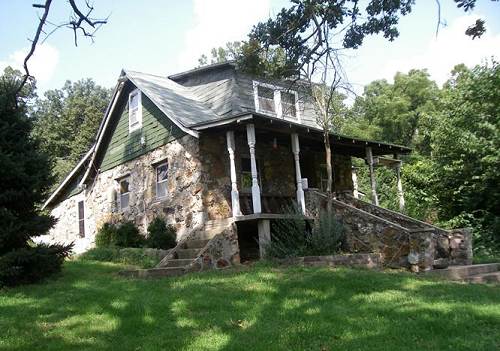
16 Earl Thompson Home
I now started into the chicken business, raised 500 to frying size, sold them at a profit of 40 cents per bird. It just took 10 weeks to raise them. This was doing real good. I built on another chicken house, this time I started out with 2000 baby chickens. The market was not so good this time, but I made a little profit. I followed the chicken business for several years, finally the market went flat I could not break even. There was a chicken dressing plant at Tuscumbia. They would dress chickens for 10 cents each. So I decided to raise them and have them dressed and sell frying chickens in Kansas City, as I knew a lot of people there. So I got up a route and peddled frying chickens and eggs. Would take 250 fryers and up to 100 dozen eggs on one trip. Did fairly good at this. When I was 65 years old in the year 1958, I retired.
I got a social security and veteran’s pension. I now have three hobbies, one is raising a truck garden and the others are pictures and music. I like to make trips in the Ozarks and visit the big springs and other scenic places. I take color slides of things of interest. I now have over 2000 color slides. In music I have a piano, cello, violin and guitar. Also, an old Edison diamond disc phonograph that still plays, a tape recorder and a console stereo Hi Fi record player. I have a large collection of records. I have a lot of old timers such as John McCormack, Fritz Kreisler, Paderewsky, Caruso, Nellie Melba, Rosa Ponselle, Nelson Eddy, Jeanette McDonald and many more (photo 17).
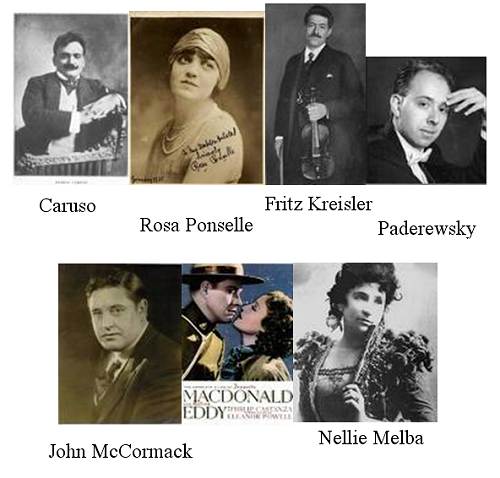
17 Classical Singers
Note: You can listen to some of Earl’s records at these websites:
Caruso:
http://www.youtube.com/watch?v=aef9DGvZ8Qo
John McCormack:
http://www.youtube.com/watch?v=WgQCPifM-p8
Fritz Kreisler:
http://www.youtube.com/watch?v=isUpNQEhotA
Paderewski:
http://www.youtube.com/watch?v=W5rKlo-nGxw
Nellie Melba:
http://www.youtube.com/watch?v=F6NnkLJlO0A
Rosa Ponselle:
http://www.youtube.com/watch?v=KrBkIaBr9Og
Nelson Eddy and Jeanette McDonald:
http://www.youtube.com/watch?v=ieuAPk3o2Z4
Mamie and I have had a lot of deep sorrow in our lives, but general speaking we have always been as happy as a pair of larks. Since we first came to the farm in 1927 quite often we would take a walk together in the woods and admire the beauty (photo 18).
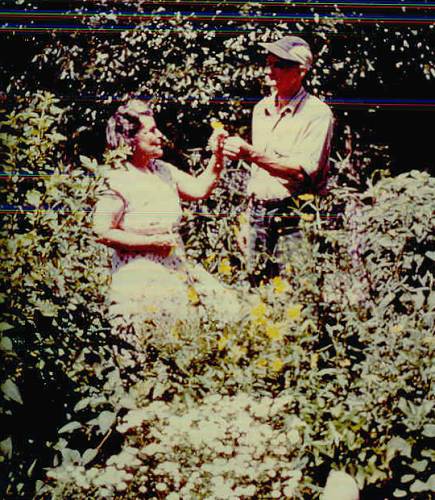
18 Mamie and Earl
Last autumn 1968, in early October I took a walk through the woods. Mamie could not go with me this time as she has arthritis and cannot walk very far at a time. It was a beautiful Indian Summer day. I started up the winding path to the top of the hill, looking at the golden rod and other flowers waving in the breeze. When I reached the top of the hill I could see for miles across the multicolored wooded hills. As I stood there gazing at the sublimity of nature I was reminded of the old saying “A picture no artist could paint.” As I wandered on through the woods I came to an old cow path that I once trod along bare footed going after the cows when just a boy. Thought I would follow it over to where the persimmons and black haws grew and see if there were any there now. Sure enough when I got there the boughs were laden with my old stand by fruit, dead ripe, seemed as though it had been waiting for my return. Once again I ate my fill; for a while it was almost like reliving my childhood. Thought I would go up and take a look at the old country school house. On my way as I strolled along the old abandoned road I thought about how we all used to travel along it going to church the old buckboard. When I got to the school house it all looked destitute and forsaken. The old school house where we were taught the three R’s was now empty and desolate. The big sturdy white oak trees that stand even now along the margin of the play ground would put forth their inviting shade in the early days of autumn, where we would sit in its coolness and eat our lunches. But now there was no one there. The playground that was once alive with the fiery flame of youth laughing and screaming, racing each other in a game of tag, ball or black man, but now the playground is empty and still. The happy hours of our youth that we spent here roaming over the old playground has been swept away by the tide of time.
The school picture was taken in the year 1900, the first school I went to (photo 19). I am in the first row, 5th one from your left. The man with the mustache on the right standing is the teacher, Dion Clark; his salary was $25.00 a month.
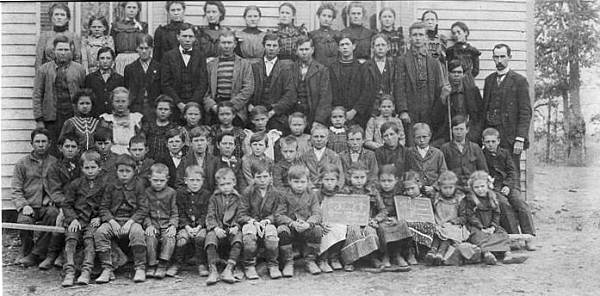
19 Ginger Ridge School - 1900
Click image for larger view
(Note: the caption for the above photo,Ginger Ridge School, as recorded on our website is as follows:
School Information:
Ginger Ridge School was located about five miles northwest of Tuscumbia on a country road. In 1907 it burned down and a concrete structure was erected. The last school taught there was in 1950-51 and Leota Slote was the teacher that year. The district then united with Tuscumbia R-III.
Students pictured in this 1900 photo are: Front: Lester Bowden, John Tracy, Elza Sibert, Willard Bowden, Earl Thompson, Manuel Cotton, Billie Odom, Effie Harris, Rosa Gilmore Rissie Cotton, Magie Meyer, Mattie Harris and Anna Carrender.
Second: Willard Carrender, Elmer Gilmore, Jim Tracy, Charles Gilmore, Lee Kallenbach, Ira Bowden, Ira Clark, Clarence Harbison, Ira Thompson, John Darity, Warren Meyer, John Harbison, Charles Carity, Roy Smith, Jim Allison.
Third: Olie Welhouns, Maud Smith, Sarah Meyer, Ethyl Odom, Mary Meyer, Mary Stepp, Mary Carrender, Jennie DArity and Vertie Sibert. Fourth: Charley Carrender, Edd Harbison, Clyde Bowden, Byron Clark, Herb Carrender, Jim Kallenbach, Oscar Carrender, Walter Wright, Lawrence Meyer, Dan Thompson, Orville Shackleford and Dion Clark, teacher.
Back : Sarah Cotton, Ema Sibert, Rena Hicks, Lizzie Bowden, Chloe Roark, Lucy Stepp, Stella Harbison, Opal Roark, Stella Cotton, Cora Allison, Rainy Shackleford and Grace Roark.)
When I look at all these familiar faces in the picture, I realize that the most of them have passed on and with the wheel of time still turning once again I am reminded of an old song “The Last Rose of Summer,” where the last verse reads like this:
“So soon may I follow, when friendships decay,
And love’s shining circle the gems drop away.
When true hearts lie withered
And fond ones have flown,
Oh, who would inhabit this bleak world alone.”
James Earl Thompson
Route 1 Box 118
Tuscumbia, Missouri
65082
Written in February, 1969.
A cousin several times removed of Earl, Clifford Hill of Eldon, gave me some additional information about him. Clifford’s family and Earl’s went to the Saline Valley Church of Christ, so they knew each other fairly well. Clifford related that Earl was a very intelligent person who had an interest in many different things. Not only was he a naturalist who knew about every tree, flower and insect in the woods, but also had a scientific bent as well. Clifford said that Earl and his brother Ira built a homemade telescope which would stay focused on a star even as the earth was rotating. Earl, according to Clifford, was an accomplished musician who played several instruments including the guitar, violin, and piano. Clifford, who himself is a champion fiddle player, said that Earl’s style was not typical of the hoedown jig dancing music played locally, but was sweet and smooth single note style, typical of the music one would expect of a man who had performed in a symphony orchestra. Earl played guitar classical style as well, using his fingers and not a pick. As Earl wrote in his autobiography, Clifford said that Earl had many old disc type records for a phonograph which mostly were recordings of classical singers and musicians. He also was a poet and oftentimes spoke in a lyrical flowery manner. But in ordinary conversation he reverted back to the speech of his childhood with the phrasing and twang of the Ozarks. It is this combination of contrasts in Earl’s life among his activities, interests and skills, to me is what represents a most unusual and interesting man.
I spent some time with Earl’s daughter, Earline and her husband, Reverend Charles Caldwell, this week to scan some photos of her father and her family (photo 20).
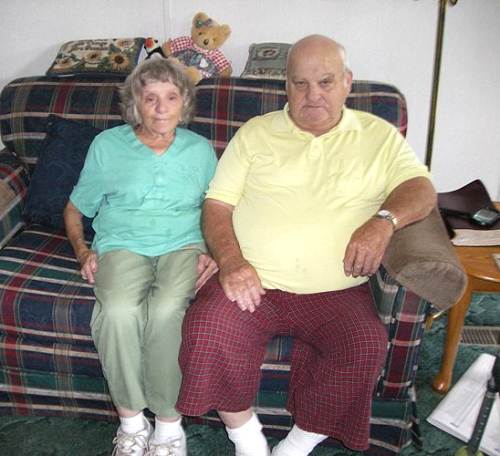
20 Earlene Thompson Caldwell and Charles Caldwell
The Caldwells’ live just a few hundred feet from Earl’s home place where he built the stone house which is where Earline was raised. For a number of years in the 1950’s the Caldwells' lived close to my wife’s home place, the Holmes Steen farm, where they raised turkeys. Earline told me that her father Earl, in addition to all his other skills, also was a carpenter and had assisted his cousin, Dan Franklin Thompson, in building the house where I was raised in Tuscumbia. I was about three or four years of age then, and while I remember Dan I hadn’t remembered Earl being there. Earline said that some “naughty boys” kept throwing walnuts at Dan and Earl when they were working on the roof of that house. Come to find out, the boys were Clifford and Stanley Hill, cousins to Dan and Earl, who lived in the hollow below our house. The point being that Thompsons’ and Thompson relatives are distributed all over the county and many families here are related due to the huge families that the Thompsons’ usually had. I had written about the Dan Franklin Thompson some few weeks ago.
For those who may be confused, two Dan Thompsons’ lived in the Little Saline creek area who were cousins. One Dan was nick named “Rabbitt Dan.” He was Earl’s half brother. The other was named “Carpenter Dan.” He was the one about whom I wrote earlier this year, especially in regard to his skills in being able to construct the cupola on the old courthouse in 1910. He was also the carpenter to whom I referred regarding the building of my father’s home just above in the narrative. These two Dans’ have been the source of a lot of confusion at times as to who was who in various stories and genealogies about the Thompsons’ of Little Saline Creek area.
For completeness of this narrative about Earl Thompson, one of our really interesting Miller County people, copied here is his obituary:
Obituary: The Eldon Advertiser 1980
James Earl Thompson, 87, Rte. 1, Tuscumbia, died Sunday, May 18, 1980, at the Miller County Nursing Home at Tuscumbia. Mr. Thompson was born April 8, 1893, at Tuscumbia to James Downing and Isabelle Wyckoff Thompson.
He first was married to Mamie Agnus Roberts on March 26, 1921, at Kansas City, Kansas. She died Nov. 25, 1972.
On October 5, 1975, he was married to Mable Jones, who survives.
In 1927 Mr. Thompson moved back to Tuscumbia from Kansas City. He was a member of the Saline Valley Church of Christ and Miller County Barracks 1442, Veterans of World War I. He was also a past member of the American Legion.
Surviving are his wife, Mable Jones Thompson, Keokuk, Iowa; five daughters, Mrs. Elnora Sears, Mrs. Grace Dake and Mrs. Marjorie Bell Jordan, all of Eldon; Lenora Thompson,
Tuscumbia, and Mrs. Francis Earline Caldwell, Brumley; two sons, Wayne E. Thompson, Eldon, and Donald Lowell Thompson, Tuscumbia; and 17 grandchildren and five great-grandchildren.
Funeral services were held at 2 p.m. Tuesday at Phillips Funeral Home in Eldon with Brother Murl Nash officiating. Burial was in the Tuscumbia Cemetery. Men from the church served as pallbearers and members of Barracks 1442 were honorary pallbearers.
In Earl’s narrative above he described the importance of bread as a staple of life saying,
“Most everyone called meal and flour bread stuff. It was generally assumed when the snow came if you had plenty of bread stuff on hand you were well heeled.”
Bread and Water are two of the most necessary components of a diet necessary to sustain life. While one could not live forever on this diet due to the lack of vitamins and minerals and protein that other foods provide, it certainly can sustain one for a long time. Long ago travelers or soldiers made sure they had water and something to eat easy to carry; many times this was bread. Prisoners were maintained for long periods of time on bread and water. Recently, in recognition of the importance of water as a basic element needed for any farm, Elmer Brown (photo 21) wrote me a narrative of how water was protected, cherished and used on his family farm.
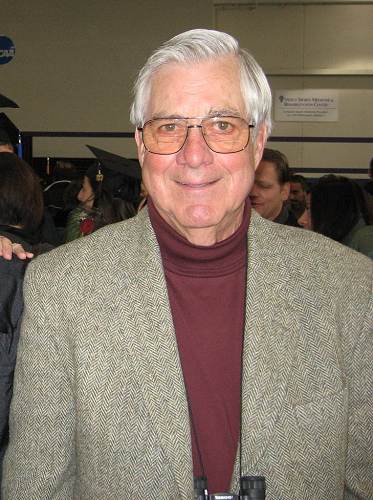
21 Elmer Brown
The narrative about water then is followed by another essay by Elmer about bread where he records some of his observations regarding the very important part of the diet is bread, especially in European countries where Elmer was stationed when he was in the service. First, the “Water” narrative:
WATER
Some of my earliest memories as a child seem to focus on water. I guess that may have to do with the fact that on the farm you are always concerned about it. Usually there is never enough due to drought or you have to carry it. Sometimes there is too much in the wrong place due to the “toad strangler” rains which frequently fall in mid Missouri after which sometimes the fences and roads are washed out and the roof becomes a sieve.
Until I was about six we got our water for the house from a spring located about 75 yards to the south where the road crossed the creek. The road has since been relocated slightly to the west so that this crossing is now the drive leading into the house.
Some enterprising soul, probably my brother Bert, had sunk a large wooden barrel in the spring so the sand and earth would not crumble into it and there would be room to dip a bucket. The spring was in a rather low spot and when the creek got up it was not unusual for the spring to flood. This typically meant that it would be filled with sand and gravel which would have to be dug out. We then would have to wait a day or two for the water to clear before we used it. We never thought about having it tested and I don’t remember boiling our drinking water so I’m sure we consumed all kinds of bacteria without knowing it. If any of us ever got sick it isn’t part of my recollections.
Water for drinking, cooking, and washing up was in a three-gallon bucket sitting on the kitchen cabinet. The common purpose dipper was either floating in the bucket or hanging on a nail nearby.
We had two chicken houses at the time. One was about half way to the barn and the other was about 75 yards up the hill directly out the back door. I never knew why they built it there but I suppose it was in effort to keep the chickens from congregating around the back door. The chickens never got the word though and you quickly developed the habit of watching where you placed your feet.
Even though the chickens were turned loose during the day unless it was bitterly cold, their water buckets still had to be filled at least twice a day. I thought I was big stuff when I got big enough to carry water and feed to them and used to beg for the chance. Not smart! It wasn’t long before I was assigned the task as a regular chore. Complaints that a full bucket was too heavy brought the response that two buckets half full would make a balanced load and work just as well.
The climb up the hill was a challenge since it was steep and pretty rough and rocky. If there was water in the creek we would fill the buckets there but there were some very dry years in the thirties, which often meant that we had to hike the extra distance to the spring during the summer.
About 1939 or 40 mother scraped together enough money to have a well drilled. They only had to go down 40 feet to find a good source and I vaguely remember that the cost was one dollar a foot. Mother told the driller, Mr. Spencer, to put it as close to the back door as possible because she wasn’t going to carry one step further than necessary.
How they got the drilling rig that close I’ll never know but the well ended up being about three feet from the door.
Uncle Harry Chalmers, mother’s sister Belle’s husband, was a carpenter and he suggested that it would not be difficult or terribly expensive to enclose the site as a screen porch. One thing led to another and it wasn’t long before we had a totally enclosed kitchen. Uncle Harry provided a pitcher pump and a sink he had taken out of a house being remodeled. I think Bert built the cabinet but it may have been Uncle Harry or his son Jack who worked with him. At any rate, we had the first running water in the community.
Water still had to be carried to the chickens but the distance was shortened considerably.
In 1949 we finally got electricity and it wasn’t long before we put in an electric pump. Most well pumps have a tank to hold water and provide an air cushion to supply pressure to force the water through. There wasn’t space for that under the sink but we found a pump, which didn’t require a tank. Even though the pump roared away under the sink every time you turned on the faucet, it was quite an improvement over the old hand pump.
By that time mother had built a much larger chicken house up near the barn. As I recall it held about 300 chickens. As you can imagine, they drank a lot more water than the 150 or so in the two old houses. There was no hill to climb but the distance was now about 125 yards instead of 75. By then mother was in her sixties and how she managed I’ll never know. I was away at college and Marie was working so she did most of it herself.
One summer I decided to run a water line to the chicken house. That meant digging the trench for the pipe by hand since it was before the days of easy rental of trenching equipment and we didn’t have the money to hire it done. You haven’t lived until you experience the joy of digging through Missouri rocks and hardpan with nothing more than a pick and shovel. Fortunately I was young, macho and not too bright so it never dawned on me that it was a sizable task to complete in the time available before I had to go back to school. Frank Martin (my brother-in-law) helped out every chance he got but still, progress seemed to be by inches.
Then the word got out in the community. It wasn’t long before neighbors were dropping by one or two at a time. They might only work an hour or so but every little bit helped. They didn’t say much but the message was clear. Mother was always ready to help them when they had a sick child or a death in the family and they were returning the favor. It wasn’t long before watering the chickens meant carrying those heavy buckets only a few feet from the hydrant rather than all the way from the house.
The other spring on the property was located in the bluff next to the creek about a quarter mile north of the house. Even in the most prolonged drought, it never went dry and often proved to be a lifesaver.
Sometime in the early thirties Bert or Norman had built a concrete dike around the small natural depression the water had eaten out in the solid limestone. We always referred to it as the Basin Spring since the basin was somewhat smaller than a round dishpan.
Before the well was drilled we had to rely on it several times for water for the house and chickens since the both the creek and the spring near the house would go dry. That meant that water had to be carried in buckets or hauled in the car if it were available.
Taking care of the cows was the least of the problem. The spring was located in their pasture and it was a simple matter to provide for them. We merely attached a longer piece of pipe to the one coming through the side of the basin and ran it into a washtub located down below.
Central Missouri always seems to be bone dry or soaked to the gills. Although the droughts can have significant economic impact and seem to go on forever, the rains also take their toll. This was especially true for us when they came down “like cats and dogs”.
The small creek that ran through the farm, one of the headwater branches of the Little Saline, was normally a trickle over the riffles with various pools that might be as much as two feet deep. Hard on the heels of one of these near cloudbursts, it could become a roaring torrent carrying logs, stumps and whatever else got in the way with water covering everything from one hillside to the other. In many places huge sections of soil were ripped out and in others huge gravel piles were deposited on what had been prime pasture or cropland.
One of the first things to be done when the water went down was check the water gaps which was what we called the sections of fence where they crossed the channel. Cows seem to have an instinct for finding holes in the fence and could put a lot of distance between themselves and home in a relatively short time.
The gaps were typically reinforced to some extent and weighted with poles and rocks on the bottom. The weights were there to hold the wire down in the channel so the cows couldn’t walk or push their way under at normal creek levels. The reinforcement also enabled the fence to survive a moderate rise with little or no damage. Unfortunately, it also helped trap various pieces of debris and the swift current would rip through as though they were constructed of kite string. Repair was sometimes as simple as removing the trash and pulling the wires back in place. Often the wire would be carried away with the trash and a complete rebuild was necessary.
Another result of the high water, which had to be dealt with, was the fords where the road crossed the creek. It seemed that the high water always gouged out a deep hole right in the crossing or deposited a huge bed of loose gravel. Cars would either drown out in the deep water or mire down in the soft gravel. If you couldn’t dig your way out you had to get someone to pull you out. Farmers who lived nearby could usually be prevailed upon, for a dollar or two, to hitch up their team and help a neighbor in distress.
I remember one instance in particular. A woman who was a stranger to the area got stuck in the crossing just at the corner of our yard and no amount of digging would get her out. I knew that our neighbor, Bert Hill, was working with his team in his field on top of the hill to the south of our house. She gladly accepted my offer to go talk to him about bringing his team and pulling her out. I made the hike up the hill and brought Bert back with me. I got our log chain out of the smoke house, helped hook it up to the car and in short order, Bert had pulled her out of the gravel. She was very grateful and gave him some money; I think it was two dollars. She didn’t even bother to thank me. I decided that if she ever got stuck next to our house again I would disappear and she could find someone to pull her out on her own.
Harold and Bob Hill and I went to Ginger Ridge School and, even in the summer, spent a lot of time together since our houses were only about a quarter of a mile apart. There was one creek hole on the Hill farm that was about two feet deep, as long as the creek had any water flowing. Being desperate to have a swimming hole in which to cool off during the hot summer days, we decided to build a dam. Working very much like beavers, we gathered logs and tree limbs, rocks, boards and anything else we could find. We constructed our dam and then filled the gaps with mud which raised the level of the pools by about a foot. It was great and we could even swim a few strokes before gouging our knees or toes on the rock and gravel bottom. Still, we really enjoyed it until the first thunderstorm. Then the creek flooded and washed our dam away. Not daunted, we rebuilt and continued to enjoy our private pool. I would also mention that it was within sight of the road and, since we didn’t bother with wearing trunks, we had to duck down below the bank when we heard a car coming. On more than one occasion though, a foot traveler would catch us unawares, to our great embarrassment.
Water on the farm is sort of a necessary evil. You can’t get along without it but oftentimes it’s difficult to get along with it.
And now Elmer’s story about the importance of bread in the diet of the French:
THE STAFF OF LIFE – FRENCH STYLE
When was the last time you bought bread in a bakeshop where the unwrapped products were stacked on open shelves like so much cordwood? When did you last buy a loaf of bread, strap it on the back of your bicycle and peddle off down the street without the slightest worry as to whether it would get soggy if it happened to be raining? Did you ever drop an unwrapped loaf of bread on the street and then pick it up and continue on your way with hardly a thought as to how unsanitary it was? Unless you have lived in France, it’s not likely that you have done any of these things. You can advance all sorts of reasons as to why you shouldn’t. It isn’t hygienic, you’ll say. It wouldn’t be fit to eat, someone else will add. And everyone will agree it just doesn’t look right.
Yet to a Frenchman, all these things are just as natural as it is for you to check the wrapping to see that it isn’t broken. And don’t get the wrong idea. Bread is not something that a Frenchman eats only once in a while. It is probably quite safe to say that the average person will consume more bread, by weight, in a day than any other single food product.
Once you have tasted it you can readily see why it is the main part of the diet. Some bakeries, or “Boulangerie” as they are called in French, may produce a product which is more pleasing to the taste of one individual than that of the shop across the street. However, this is a matter of opinion. Whether you buy a loaf fresh from the oven and snack on it as you walk down the street window shopping, or whether you are dining in the best restaurant in town with a tuxedoed waiter hovering near by and the bread is served in a napkin lined basket with plenty of butter to go on it, your “pain” is the same product. And it’s all good!
French bread comes in many sizes and shapes, but for the most part the ingredients are the same. The only difference being the proportion of crust to center. It ranges from “Fiscelle”, which is the long very slender loaf; through “Baguette”, also long but somewhat thicker; to “Gros Pain”, which literally translated means large bread. The closest thing to our common American loaf is “Pain Biscotte” which means square loaf.
There are as many ways of enjoying this wonderful food as there are days in the month. As was mentioned before, it is a delicious snack when your wife is dragging you up one street and down another on a shopping spree. And if you have time to stop at a sidewalk for a moment there is nothing better than a “Sandwich Jambon”, or as we would say in English, a ham sandwich. Another delightful way to surround the staff of life is when you sit down to a tasty course of “Escargot”. For pure delight to the palate there is nothing better than popping a snail into your mouth and then picking up his shell and pouring the melted garlic butter, in which he was broiled, onto a piece of bread and chasing him down with that.
But probably better than any other way is to have it with your meal. Yours truly has been known to make away with a whole loaf of bread and at least a quarter pound of butter while waiting for the main course to be served. In defense, I might add that the French do not believe in rushing through a meal.
And yet, food is not the only use made of this versatile product. It can be, and sometime is used as a weapon. Your author was somewhat stunned, a few days after his arrival in this foreign land, to observe an angry mother cuff her obstreperous young son into obedience with a loaf of bread and then nonchalantly herd him down the street while munching on her club.
Toast anyone?
(While I was stationed in France in the late 1950s my sister Kathleen asked me to send a piece which characterized the French lifestyle and which she could share with the members of a club to which she belonged. My first wife, Mary, and I collaborated in producing the short essay above. - Elmer Brown)
Thanks Elmer.
We were delighted this last week to host the “Red Hat” ladies of Iberia at our museum (photo 22). The ladies enjoyed their tour of the museum as many of the displays contain items and artifacts which were donated by Iberia people. They were especially interested in the display featuring the Iberia Academy.
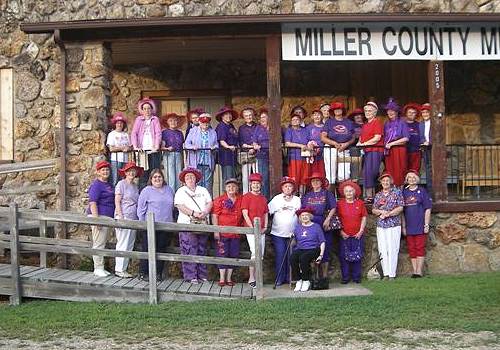
22 Iberia Red Hat Society
As you pass by the museum next time you might notice we have a new sign (photo 23).
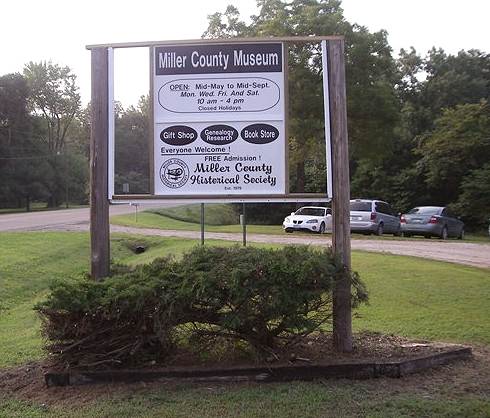
23 New Museum Sign
We are very thankful to Jim Clark and Carl McDonald for their work in trimming out some of the shrubs and the large tree which were partially covering the old sign, and we are appreciative of the work Jim did in making the new sign.
Don’t forget the car show scheduled for Saturday, September 13 on the museum grounds. The cars will be vintage 1950’s for the most part but quite a few older ones will be shown as well. Meals will be available for a small fee; the show itself is free.
Museums and libraries always have to be careful about preventing mold from attacking rare manuscripts and books because the mold eventually will destroy the paper upon which important original information is recorded. Our new museum addition was designed to prevent mold accumulation and our staff follows careful environmental guidelines to inhibit the growth of mold spores. Recently, we received a number of old school records originally from some of the one room schools which were common in the county more than fifty years ago (photo 24).
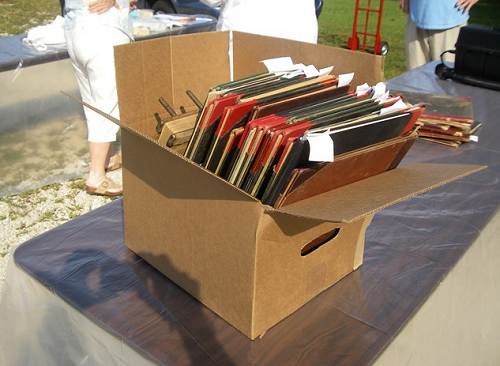
24 Old Record Books
Some of these records were badly contaminated by mold such that the staff at the Missouri State Archives requested they undergo special mold removal techniques before being accepted for microfilming. So last Thursday Sandy File and Diane McKinnen from the Local Records division of the State Archives came to the museum to assist us in cleaning the school records (photo 25).
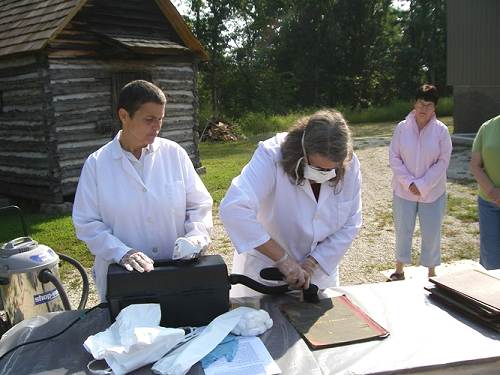
25 Sandy File and Diane McKinnen Vacuming Files
They instructed our staff, which consisted mostly of board members, in the proper technique (photo 26).
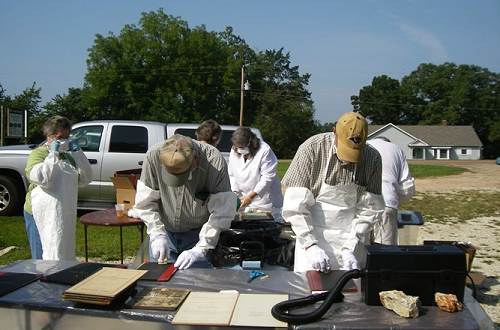
26 Hand Scrubbing
Protective clothing, masks and gloves were recommended to prevent mold related illness (photo 27).
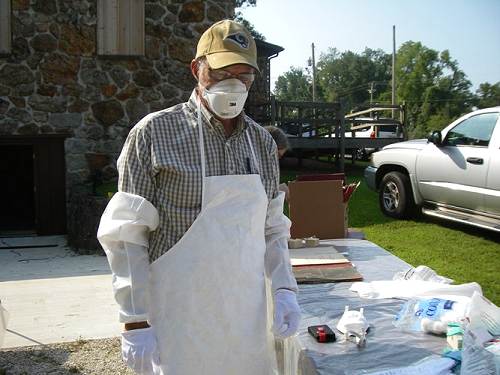
27 Protective Clothing
Sunlight inhibits mold growth so the cleaning and disinfecting process had to be done under the sun which for some of the staff also required sun protection (photo 28).
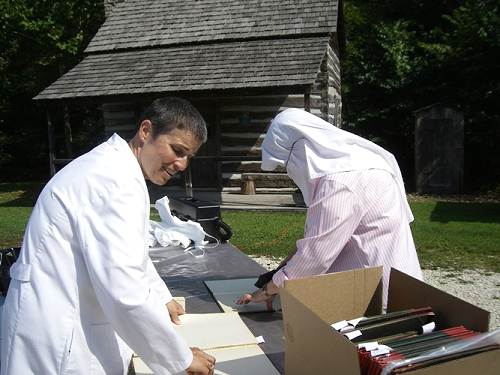
28 Skin Protection
If you want to learn more about mold’s effect on library contents you can read this attachment: (photo 29).
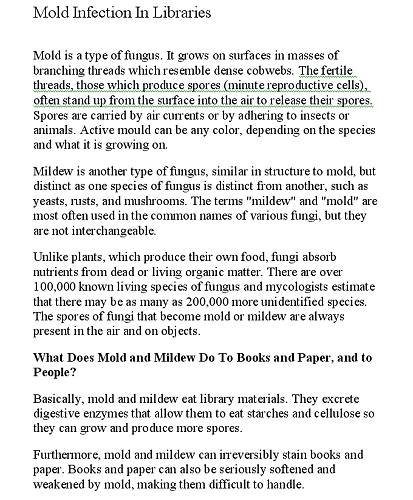
29 Mold Document
Click image to view the full MS Word Document or
Right-Click, then Save As... to download the Document
That's all for this week.
|



